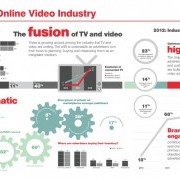
AdMonsters’ upcoming OPS TV event, July 11 in NYC, is not about the convergence of TV and digital video, but instead an examination of the growing overlap between the two channels. Signaling this increasinly convoluted relationship was Adap.tv’s 2012 First Quarter State of the Online Video Industry Report, which found that 48% of marketers and angencies are currently buying TV and digital video together and 73% plan to in the next 12 months.
We caught up with Teg Grenager, Cofounder and Vice President of Product for Adap.tv (an OPS TV sponsor), to get his thoughts on the key takeaways from the aforementioned report, the growth of video RTB, video metrics and the new App Center offering for marketers and publishers.
 What finding surprised you the most in the first quarter State of the Online Video report? What stats should publishers pay the most attention to?
What finding surprised you the most in the first quarter State of the Online Video report? What stats should publishers pay the most attention to?
We had a hunch that buyers were starting to think about planning and buying TV and online video together, but we were surprised to learn that 48% of respondents were already doing it. Publishers should pay close attention to the fact that buyers are consolidating the buying of TV and digital video.
They shouldn’t be positioning their digital video media in the same way that they position their display media. Their proposals for digital video RFPs should look a lot more like TV proposals, not like display. They need to contain reach/frequency and TRPs, not impressions and click through rate.
What was the impetus for building the App Center, and what were the chief difficulties in bringing it to life? What are the main advantages for publishers?
We noticed that more and more of the video campaigns running on the Adap.tv platform were using technologies from third-party vendors, including audience targeting data, audience measurement, interactive pre-roll formats, ad verification, and many more. And it was becoming a headache for our users to manage – signing terms with multiple providers, logging in to multiple consoles, etc. So we decided to streamline this process for our users, in a very scalable way – by defining a core set of APIs that enabled these third-party vendors to build “Apps” in our platform.
How much of digital video buying is likely to be RTB-based by the end of 2012? 2013? What will drive this growth?
We believe that in the future, the majority of all advertising will be traded using programmatic tools. However, programmatic trading doesn’t just entail real-time bidding. Real-time bidding is a great technology for connecting the middlemen of our industry in a way that allows for optimization of direct response campaigns, but it’s not clear that it’s the right vehicle for buying/managing brand campaigns. For example, we believe that programmatic trading of future inventory will also play a key role. However, RTB will continue to grow, and publishers should make sure that they enable their inventory for RTB as well as newer programmatic trading methods.
What’s in it for the publisher in jumping into the RTB game? In particular, why should video publishers take an interest in private video marketplaces?
To maximize ad revenue, publishers need to make sure that they are open to as many sources of demand as possible, and that they make these demand sources compete for their inventory, thereby maximizing their yield. This is precisely what a private marketplace accomplishes – it allows them to invite a large number of buyers and have them compete, while retaining a high level of control. We have data from our customers that shows that CPM and fill rate increase as the number of buyers grows.
 Have brands and agencies stopped worrying and started to love the online GRP? Is this the holy “unified metric” they’ve been waiting for, or is there room for another to bloom? How would widespread adoption of GRPs shake up the video industry?
Have brands and agencies stopped worrying and started to love the online GRP? Is this the holy “unified metric” they’ve been waiting for, or is there room for another to bloom? How would widespread adoption of GRPs shake up the video industry?
The GRP – and better yet the targeted ratings point (TRP) – is definitely the right metric for brand advertisers to use in planning and measurement of video campaigns. While direct response advertisers care primarily about driving online “conversions” – purchases, subscriptions, or just web traffic – brand advertisers care primarily about displaying their brand message to a large number of viewers in an audience that is likely to be receptive.
And this is precisely what TRPs measure – the reach and frequency against your target audience. TRPs will be the primary way in which brand advertisers plan and measure digital video. The impact will be that publishers will have to get much better at delivering against the brands’ target audiences.
How do you see ad operations professionals changing the video advertising landscape?
If ad ops professionals want to create real value for advertisers, they will get very good at knowing their audiences, and targeting campaigns to hit target audiences with precision. Nielsen will be watching.
What do you see as the biggest challenge right now for publishers on the video side? What troubles are looming in the distance?
Figuring out how to optimize revenue between the IOs coming in from the direct sales team and the revenue coming in from programmatic sources.
 |
Pondering the future of TV and digital video? OPS TV will bring digital advertising leaders and ops professionals together to discuss the intersection of digital video and TV advertising. Register today for OPS TV, which will be held July 11, 2012, in New York. |